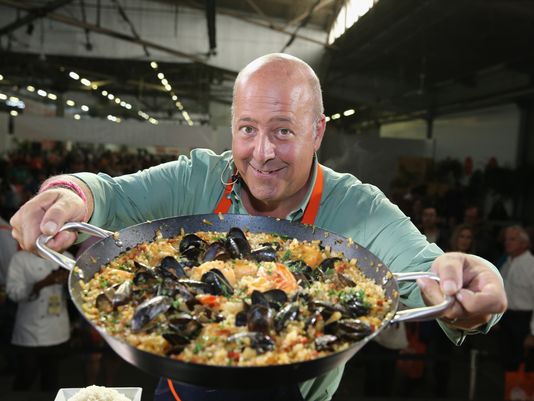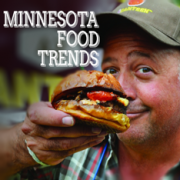Foodie Andrew Zimmern Sees Minnesota Carve Trends
Travel Channel TV star Andrew Zimmern has been to St. Cloud. Find out where he went to eat and what it’s like being part of Minnesota’s booming culinary experience.

TV personality Andrew Zimmern runs a presentation during the New York City Wine & Food Festival at Pier 94 on Oct. 18 in New York City. Zimmern says Minnesota’s food scene has gained a strong reputation in recent years. PHOTO: Getty Images
Andrew Zimmern didn’t grow up in Minnesota. But the chef turned television personality has certainly embraced living in the North Star state with his wife and son.
Since he arrived in 1992, Zimmern has noticed a booming cultural culinary progression.
“If you are in New York, it’s hard to see these things noticed because there’s so many different food movements going on at the same time,” Zimmern said. “The cool thing about being in Minnesota is that you can see something go from 10 mph to 50 mph and actually feel like you have a seat on the bus. That’s great to be part of creating something in my hometown.”
Zimmern said the cultural progress hasn’t been limited to the Twin Cities.
“Even those gateway towns to the Boundary Waters and North Shore never offered a lot in terms of food, but now there a dozen of great restaurants, food companies and places that have a national presence or reputation,” he said.
Through his Travel Channel shows “Bizarre Foods” and “Bizarre Foods America,” Zimmern has been able to explore cultures and food from all around the world.
But he’s also been through St. Cloud, where he remembers having a burger at Val’s Rapid-Serv and attending a football game at Husky Stadium.
“I haven’t spent a lot of time in St. Cloud, but it’s a great community with great people.”
Zimmern has a food truck that stops throughout the Twin Cities, including a permanent stand at Target Field — where he was part of the celebrity softball game for the 2014 MLB All-Star Game.
He also has a podcast and recently released a new line of cookware inspired by items he noticed traveling the world.
And he recently chatted by phone about Minnesota’s culinary progress and the special traits that make this state unique.
Question: What has it been like living in Minnesota?
Answer: Oh, my gosh. To me, this has been the best place in the world. Mostly because the 21st century food culture has been allowed to flourish here in an untampered-with sort of fashion. It seems like with New York or LA there are a lot of other contributing factors and circumstances that bend, twist and shape the culture in some ways that aren’t natural. They exist, so in that sense they are natural, but it’s not the explosion of the love of food and the connection to farm and the sort of happy cosmic set of circumstances that have propelled this community and state into the national conversation of food in a very effortless way.
Q: Before you moved to Minnesota, what was your impression of the culture?
A: Oh, it was terrible. I knew nothing of it beforehand, but when I arrived here there were a handful of restaurants that were 10-15 years behind the times. There was very little statewide food culture. There were a lot of overly Americanized ethnic restaurants. There was no hometown pride when it came to the food scene. Luckily, there was a small cluster of very committed culinarians that helped paved the way for this current generation. Because we are a pretty close-knit community, the current group of people in the food service business statewide have a great appreciation for those folks and a connection to them. There was not a restaurant scene here in terms of a national conversation. There was nothing. I mean that in the national sense of reputation, not to insult the very successful trailblazers. They were a small voice screaming into the wind. They spawned a food culture 25 years later.
Q: What was it like shooting the Minnesota editions of “Bizarre Foods” and “Bizarre Foods America”?
A: It was fun, but more importantly, I insist that every project I do has some connection to where I live now. I think it’s important to grow where you are planted. My show is in 70 countries and I make TV all over the world but I want to make sure every year I shoot something in Minnesota, whether it is for my Web series, my TV series, whatever. I like to tether what I’m doing to my community here because I think it is important as a citizen to not only eat sustainably but to do business sustainably. I think sustainability is something that’s tossed around like it’s some sort of niche thing — it’s not. It should be economic sustainability, agricultural sustainability, emotional sustainability — I believe in supporting my community.
Q: What’s the most bizarre thing you’ve ever eaten in Minnesota?
A: Lutefisk. It’s the worst thing ever invented. It makes no sense. Everyone here says ‘Oh, all the grandmothers in Scandinavia eat it.’ And all the grandmothers in Scandinavia tell me that they would never touch it. It’s just awful.
Q: When you are traveling, what do people say about Minnesota?
A: Everybody knows Minnesota. Frequently they ask about the president of Minnesota Jesse Ventura. I tell them ‘He used to be the governor.’ Sometimes there’s Vikings fans. Sometimes people only know Mall of America. But almost everybody knows the natural wonders of the Great Lakes and what our state represents top to bottom. In the last five years, I’ve done a lot of communication all over the world trying to drive home the fact what used to be fly-over country is now leading the way in terms of food trends. Everywhere else in the country, they are trying to talk about farm-to-table connections. Here in Minnesota we’ve never lost that — everybody can reach out and touch a farmer in Minnesota. They talk about the home arts and pieing and canning and pickling, we’ve never lost that. They talk about the lost meat arts and hobby cooking, like making your own bacon and instead of just cooking with it. We’ve never lost that. We’ve always been about those types of things. I think it’s interesting on an international level. The Upper Midwest is where everything is happening.
Q: What do you learn about other cultures by sharing a meal?
A: I’ve always thought a handful of ideas were true: Food is great, food with a story is better, food with a story people haven’t heard yet is best of all. I’ve felt that in a world where we have always defined ourselves by our differences, that we might want to talk about our commonalities. Rather than politics, sex, religion, skin color, language, let’s talk about food. I’ve never left a table with someone not understanding them better. I wanted to tie all of that together. I learn more about someone’s culture having dinner in their house than walking through a museum. I’m not anti-museum, I’m just pro dinner party.
| Andrew Zimmern’s Thanksgiving Stuffing |
|---|
|
8 cups dry, seasoned bread cubes (bagged stuffing cubes from the supermarket are OK) 2 tablespoons fresh minced sage leaves 1 pound fresh chestnuts, in the shell Turkey liver and gizzard from the bird, minced fine 3 ounces fresh chicken livers, minced 1 cup minced celery 1 cup minced Spanish (yellow) onion 1 tablespoon melted butter 2 tablespoons minced parsley 1 tablespoon fresh thyme leaves one Combine stuffing ingredients in a large mixing bowl. Season with salt and pepper. two Stuff turkey front and back. Place any extra stuffing in a suitable oven-to-table casserole dish. three Cover loosely with aluminum foil. four Heat oven to 375 degrees. Bake for 35-40 minutes. For more recipes, visit http://andrewzimmern.com/category/recipes/. |




